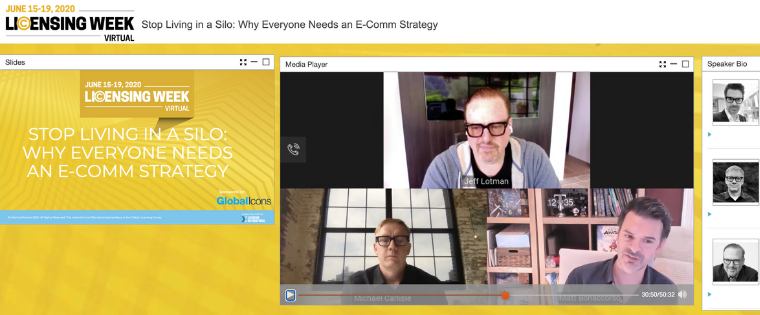The Value of a Well-Designed eCommerce Strategy

The benefit to a brand that crafts a well thought out eCommerce strategy goes well beyond the immediate revenue that’s generated. It’s about data and insights, customer relationships, micro-targeting and the chance to control how the brand is portrayed.
That was the overarching message of the Discovery’s Matt Bonacorsso and The Wildflower Group’s Michael Carlisle in a webinar moderated by Jeff Lotman of Global Icons – “Why Everyone Needs an E-Comm Strategy” — during the first day of Licensing Week Virtual. While acknowledging the importance of participating in the Amazon ecosphere – Carlisle cited studies that the behemoth scoops up 51 cents of every eCommerce dollar – they also made the case for a brand to build a rich, strategic storefront of its own on another platform.
Building the business
“Regardless of where customers are looking to purchase products from any company today, you can bet they’re first going to search for those items online. So, having an effective eComm strategy can help build your business across the entire portfolio of distribution channels that you have,” said Bonaccorso. That includes brick and mortar. “If we’re going into a retail meeting, we have data from three months of our own eComm; that’s powerful and can make the difference between getting four skus and five skus; that’s a huge difference.”
Other benefits:
- Product development. “This is a testing lab for us. There are things you could never test 10-15 years ago that are now very easy to do,” Bonaccorso said.
- Relationship. “People talk about the lifetime value of a customer,” said Carlisle. “That really comes into play when you’re able to communicate with them and market to them and also learn from them.”
Bonaccorso acknowledges that it’s a “difficult business” with lots of moving parts to plan and coordinate – customer support, fulfillment, the website, creative, planning the calendars, working internally with all the brand teams, all the programming teams – particularly in an era when “Amazon has trained us as consumers” to expect such things as quick shipping and seamless payment.
Carlisle says a brand store needs to have a healthy assortment of product, whether self-sourced or from licensees. “Assortment drives conversion. So, if you’re able to bring in product from your licensees – drop shipping is a great way to do it – it’s important in adding to the mix.” In essence, the brand’s store can be positioned to the licensee as just another wholesale customer, with royalties paid on those sales just like any other… It can be positioned as just another retail store, so you’re buying wholesale and they’re paying a royalty on it.
How do you know if you’re doing it well? “The metric you want to look at is how many times are you having that customer come back to purchase from you again, and what is that conversion rate when they come back to your store,” said Bonaccorso.




